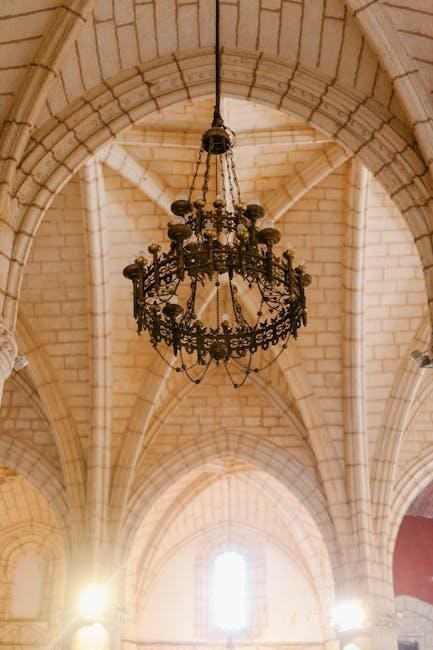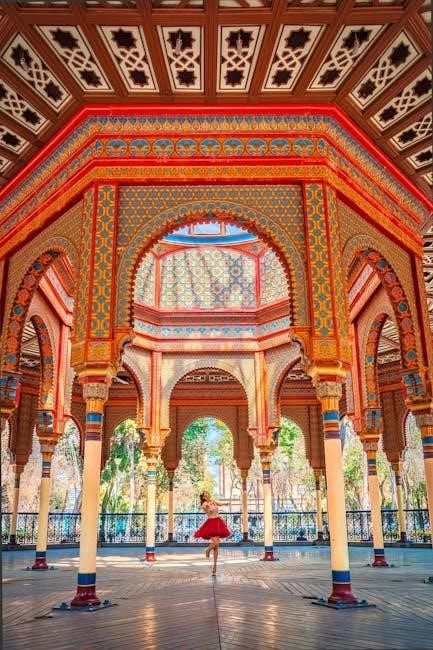The Virgin Mary, a central figure in Christianity, was born in Nazareth to Saints Joachim and Anne․ Her divine calling and acceptance of God’s plan mark her significance in salvation history․
1․1․ Overview of the Life of the Virgin Mary
The Virgin Mary, born in Nazareth to Saints Joachim and Anne, lived a life of profound devotion and humility․ She was chosen by God to bear Jesus, embodying faith and obedience․ Her marriage to Joseph and the Annunciation marked the beginning of her divine mission․ Mary’s life, rooted in prayer and service, culminated in her role as the Mother of God and a central figure in Christian devotion․
1․2․ Historical and Religious Significance
The Virgin Mary holds unparalleled historical and religious significance as the Mother of God and a pivotal figure in Christian theology․ Her perpetual virginity, divine maternity, and unwavering faith embody key doctrines․ Mary’s role in the Incarnation and salvation plan, as well as her intercessory power, has made her a universal symbol of hope, devotion, and divine grace, deeply venerated across centuries and cultures․

Early Life of the Virgin Mary
The Virgin Mary was born in Nazareth to Saints Joachim and Anne, pious parents of priestly lineage․ Her early life was marked by humility and devotion to God․
2․1․ Birth and Parentage (Saints Joachim and Anne)
The Virgin Mary was born in Nazareth to Saints Joachim and Anne, her pious parents․ They were of priestly lineage, descending from King David․ Her birth was a fulfillment of divine providence, marking the beginning of a life dedicated to God․ Mary’s upbringing in a devout household laid the foundation for her humble and virtuous character, preparing her for her sacred role in salvation history․
2․2․ Upbringing in Nazareth
Mary was raised in Nazareth by her devout parents, Saints Joachim and Anne, in a humble and faith-filled environment․ Her upbringing instilled in her a deep love for God and a life of virtue․ Known for her prayerful nature and contemplative spirit, Mary’s early years prepared her for her divine mission․ Her daily life reflected simplicity, dedication, and a profound connection to her faith, shaping her character as a handmaid of the Lord․
The Annunciation and Divine Calling
The Archangel Gabriel visited Mary in Nazareth, announcing God’s plan for her to bear Jesus․ Her humble acceptance, “Let it be done to me according to your will,” sealed the Incarnation, restoring humanity’s relationship with God․
3․1․ The Visit of the Archangel Gabriel
The Archangel Gabriel appeared to Mary in Nazareth, announcing she would bear Jesus, the Son of God․ This divine encounter, known as the Annunciation, marked the beginning of Mary’s role as the Mother of God․ Gabriel’s message emphasized God’s grace and Mary’s unique calling, setting the stage for her fiat, or acceptance, of God’s will, which would forever alter human history and salvation․
3․2․ Mary’s Fiat and the Incarnation
Mary’s fiat, her unconditional “yes” to God’s will, marked the pivotal moment of the Incarnation․ By accepting the divine plan, she became the vessel through which God became human, restoring the broken relationship between the Creator and humanity․ Her faith and obedience opened the way for the Savior’s birth, fulfilling the promise of redemption and initiating a new covenant with mankind․

The Virgin Mary and Saint Joseph
The Virgin Mary and Saint Joseph formed a humble and devout union, living in Nazareth․ Their marriage, rooted in faith, exemplified dedication to God and their divine mission․
4․1․ The Marriage and Journey to Bethlehem
The marriage of the Virgin Mary and Saint Joseph was a humble union rooted in faith and obedience to God’s will․ They lived in Nazareth, where Joseph worked as a carpinter․ When ordered to register in Bethlehem, they embarked on a challenging journey, driven by faith despite the discomforts of travel․ This journey marked the beginning of the events leading to the birth of Jesus․
4․2․ The Nativity of Jesus
The Nativity of Jesus occurred in Bethlehem, where Mary and Joseph had traveled for a census․ Finding no room at the inn, they took shelter in a manger, where Jesus was born․ This humble birth, surrounded by simplicity and divine grace, marked the fulfillment of prophecy and the beginning of Jesus’ mission․ Mary’s faith and trust in God shone brightly in this moment․

The Virgin Mary as the Mother of God
Mary, as the Mother of God, holds a central role in Christian theology, embodying divine grace and faith․ Her title reflects her sacred mission in the salvation plan․
5․1․ The Theological Title “Mother of God”
The title “Mother of God” (Theotokos) underscores Mary’s divine motherhood, affirming her role in bearing Jesus, both human and divine; This theological title, established at the Council of Ephesus, reflects her unique place in Christian doctrine, emphasizing the unity of Christ’s nature․ It highlights Mary’s perpetual virginity and her sacred mission in the mystery of salvation, solidifying her veneration in Catholic tradition and devotion․
5․2․ Her Role in the Salvation Plan
Mary’s role in the salvation plan is pivotal․ Her fiat, or unconditional acceptance of God’s will, enabled the Incarnation of Jesus, bridging humanity’s divide from God․ Through her faith and obedience, Mary became the vessel of redemption, embodying divine grace․ Her maternal love and steadfast faith exemplify her central role in God’s plan, making her a cornerstone of Christian theology and devotion, as she nurtured the Savior who brought salvation to mankind․

The Virgin Mary’s Intercessory Role
Mary is revered as humanity’s interlocutor with God, exemplified by her intercession at the Wedding of Cana, demonstrating her maternal care and divine advocacy for human needs․
6․1․ The Miracle at the Wedding of Cana
Mary’s intercession at the Wedding of Cana highlights her role as a compassionate advocate․ When the wine ran out, she entrusted the situation to Jesus, who transformed water into wine, showcasing divine power and affirming Mary’s faith․ This miracle, recorded in John 2:1-11, underscores her maternal care and ability to mediate between humanity and God, inspiring devotion and trust in her intercessory power․
6․2․ Mary’s Intercession in Catholic Devotion
Mary’s intercession is a cornerstone of Catholic devotion, reflecting her maternal role in mediating between God and humanity․ Devotees seek her prayers, inspired by her titles like “Mother of God” and apparitions such as Our Lady of Fátima․ Her perpetual virginity and divine motherhood reinforce her unique intercessory role, making her a powerful advocate in the lives of the faithful, especially in times of need or celebration;

The Passion and Death of Jesus
Mary stood at the foot of the cross, embodying profound sorrow and unwavering faith as she witnessed her Son’s crucifixion, fulfilling His divine mission․
7․1․ Mary at the Foot of the Cross
Mary stood at the foot of the cross, witnessing her Son’s crucifixion with profound sorrow and unwavering faith․ Her presence reflected maternal love and devotion, even in the face of immense suffering․ This moment, marked by both grief and trust in God’s plan, underscores her role as a mother and disciple, embodying the depth of her faith and sacrifice․
7․2․ Her Sorrow and Faith
Mary’s sorrow at the cross was profound, yet her faith remained unshaken․ She accepted God’s plan, embodying perfect submission and trust․ Her grief was not despair but a deepening of her faith, reflecting her unwavering devotion to God’s will; This moment highlights her strength as a mother and disciple, offering a powerful example of faith amidst suffering․

The Assumption of the Virgin Mary
The Assumption of the Virgin Mary is a Catholic doctrine celebrating her bodily ascent to heaven at the end of her earthly life․ It signifies her complete union with God, emphasizing her sinless life and divine motherhood․ This belief underscores her unique role in salvation history and is deeply revered in Catholic tradition․
8․1․ The Doctrine of the Assumption
The Doctrine of the Assumption states that the Virgin Mary was taken up to heaven, body and soul, at the end of her earthly life․ This Catholic belief emphasizes her sinless life and divine motherhood, reflecting her perfect union with God․ Celebrated on August 15, it underscores her unique role in salvation history and remains a cornerstone of Marian devotion in the Catholic Church․
8․2․ Celebration and Significance
The Assumption of the Virgin Mary is celebrated on August 15, honoring her glorious entry into heaven․ This feast is a time of great joy, marked by liturgical celebrations, processions, and devotional prayers․ It highlights Mary’s divine motherhood and her perfect union with God, inspiring believers to seek her intercession․ The celebration underscores her role as a spiritual mother and the ultimate fulfillment of her earthly life in heavenly glory․

Titles and Devotions to the Virgin Mary
The Virgin Mary holds numerous titles, such as Mother of God, Our Lady of Fátima, and the Immaculate Heart, reflecting her divine role and universal devotion across cultures․
9․1․ The Immaculate Heart of Mary
The Immaculate Heart of Mary symbolizes her pure and loving devotion to God․ It represents her untainted soul, free from sin, and her profound maternal love for humanity․ This title emphasizes her perfect alignment with God’s will, embodying virtues like compassion and sacrifice․ Devotion to the Immaculate Heart is a cornerstone of Marian spirituality, inspiring Catholics worldwide to seek her intercession and follow her example of faith and purity․
9․2․ Our Lady of Fátima and Other Apparitions
Our Lady of Fátima refers to the Virgin Mary’s apparitions to three children in Fátima, Portugal, in 1917․ She emphasized prayer, penance, and conversion, leaving a lasting impact on Catholic devotion․ These apparitions, along with others like Lourdes, highlight Mary’s role as a mediator of God’s grace and a source of hope, inspiring millions to seek her intercession and reflect on divine messages․

The Virgin Mary in Art and Culture
The Virgin Mary’s life has inspired countless artistic masterpieces, from medieval paintings to modern sculptures․ Her cultural impact spans literature, music, and traditions worldwide, reflecting her universal significance․
10․1․ Depictions in Religious Art
The Virgin Mary has been a central subject in religious art, inspiring masterpieces that depict her life, from the Annunciation to the Assumption․ Often portrayed with a serene expression, she is frequently shown in blue attire, symbolizing purity․ Scenes like the Nativity, the Crucifixion, and the Miracle at Cana highlight her divine role․ These depictions vary across cultures, reflecting diverse artistic styles and theological interpretations of her sacred presence․
10․2․ Cultural Impact Across the World
The Virgin Mary’s influence extends globally, shaping cultures and traditions․ In Mexico, she is revered as Our Lady of Guadalupe, a national symbol․ Argentina honors her as Our Lady of Luján, embodying cultural identity․ Portugal celebrates the apparitions at Fátima, drawing pilgrims worldwide․ These examples highlight Mary’s role in uniting diverse communities through faith and devotion, making her a universal symbol of maternal love and spiritual guidance․

The Virgin Mary in Catholic Liturgy
The Virgin Mary holds a central place in Catholic liturgy, celebrated through feasts like the Assumption and Immaculate Conception, and revered in prayers and hymns dedicated to her intercession․
11․1․ Feasts and Solemnities
The Catholic Church honors the Virgin Mary through several significant feasts, including the Assumption on August 15, celebrating her heavenly ascent, and the Immaculate Conception on December 8, marking her sinless conception․ Additionally, the Nativity of Mary on September 8 commemorates her birth, while May dedications highlight her maternal role․ These solemnities underscore her divine importance in Catholic liturgy and devotion․
11․2․ Marian Prayers and Hymns
Marian prayers and hymns, such as the “Ave María” and “Salve Regina,” express deep devotion to the Virgin Mary, honoring her role as the Mother of God․ These prayers, rooted in Catholic tradition, reflect her intercessory role and maternal love․ Hymns like “Regina Coeli” celebrate her joy in Christ’s resurrection, while others seek her guidance and protection, enriching Catholic spirituality and fostering a connection with her divine motherhood․
The Virgin Mary’s life exemplifies faith, humility, and divine purpose, inspiring believers worldwide․ Her legacy as Mother of God and intercessor endures, guiding humanity toward spiritual renewal and grace․
12․1․ The Universal Appeal of the Virgin Mary
The Virgin Mary’s universal appeal lies in her compassionate heart and unwavering faith, making her a symbol of hope and maternal love for people across cultures and faiths․ Her life embodies spiritual strength, inspiring devotion and reflection worldwide․ As a bridge between humanity and the divine, Mary’s legacy transcends boundaries, fostering unity and inspiring countless generations to seek solace in her intercession and grace․
12․2․ Her Legacy in the Modern World
The Virgin Mary’s legacy endures as a timeless symbol of faith, compassion, and maternal love․ Her apparitions, such as at Fátima, continue to inspire devotion globally․ Modern spirituality draws strength from her example of surrender and trust in God․ Mary remains a unifying figure, bridging cultures and generations, guiding humanity toward hope, service, and divine connection in an ever-changing world․
